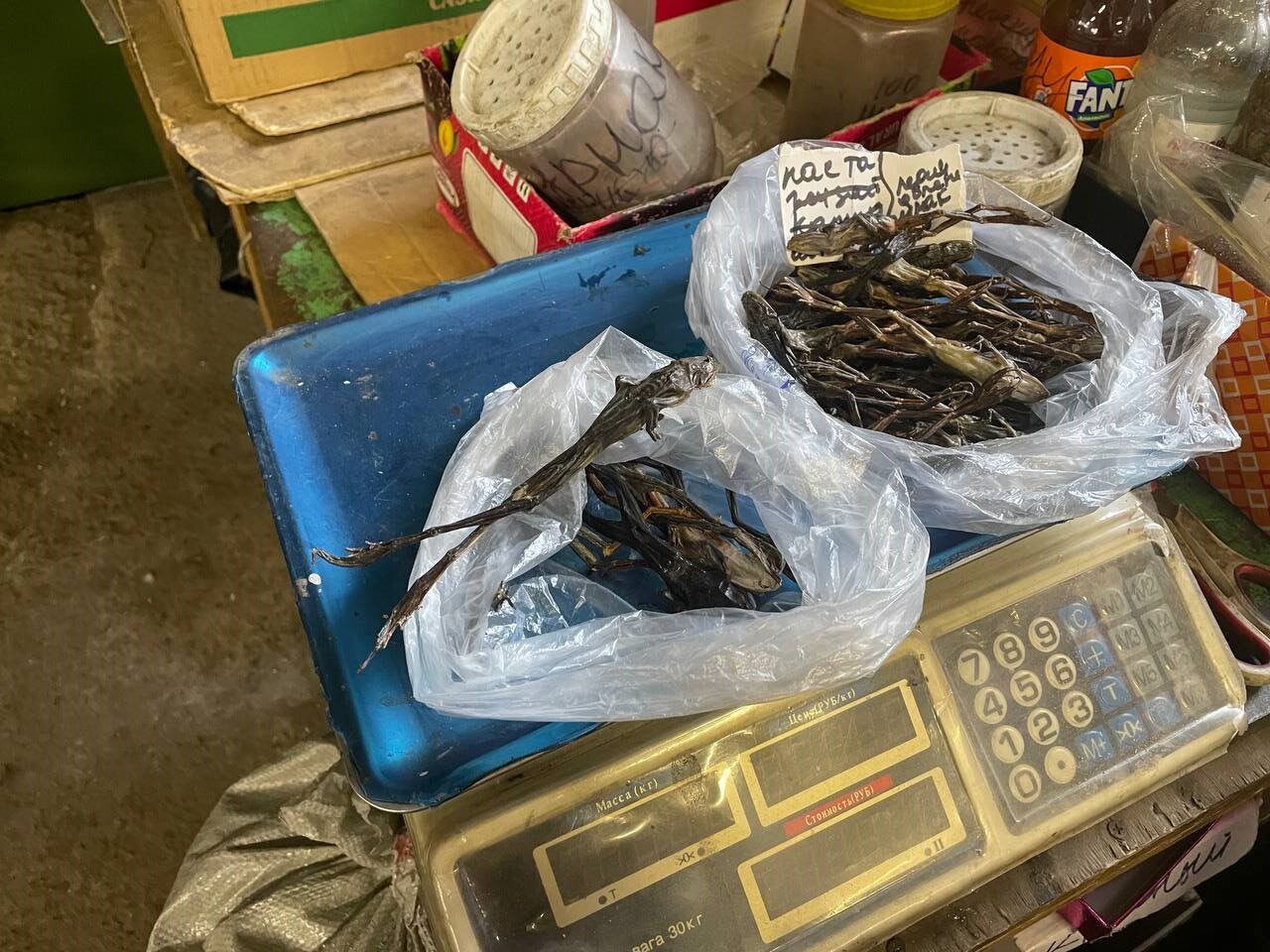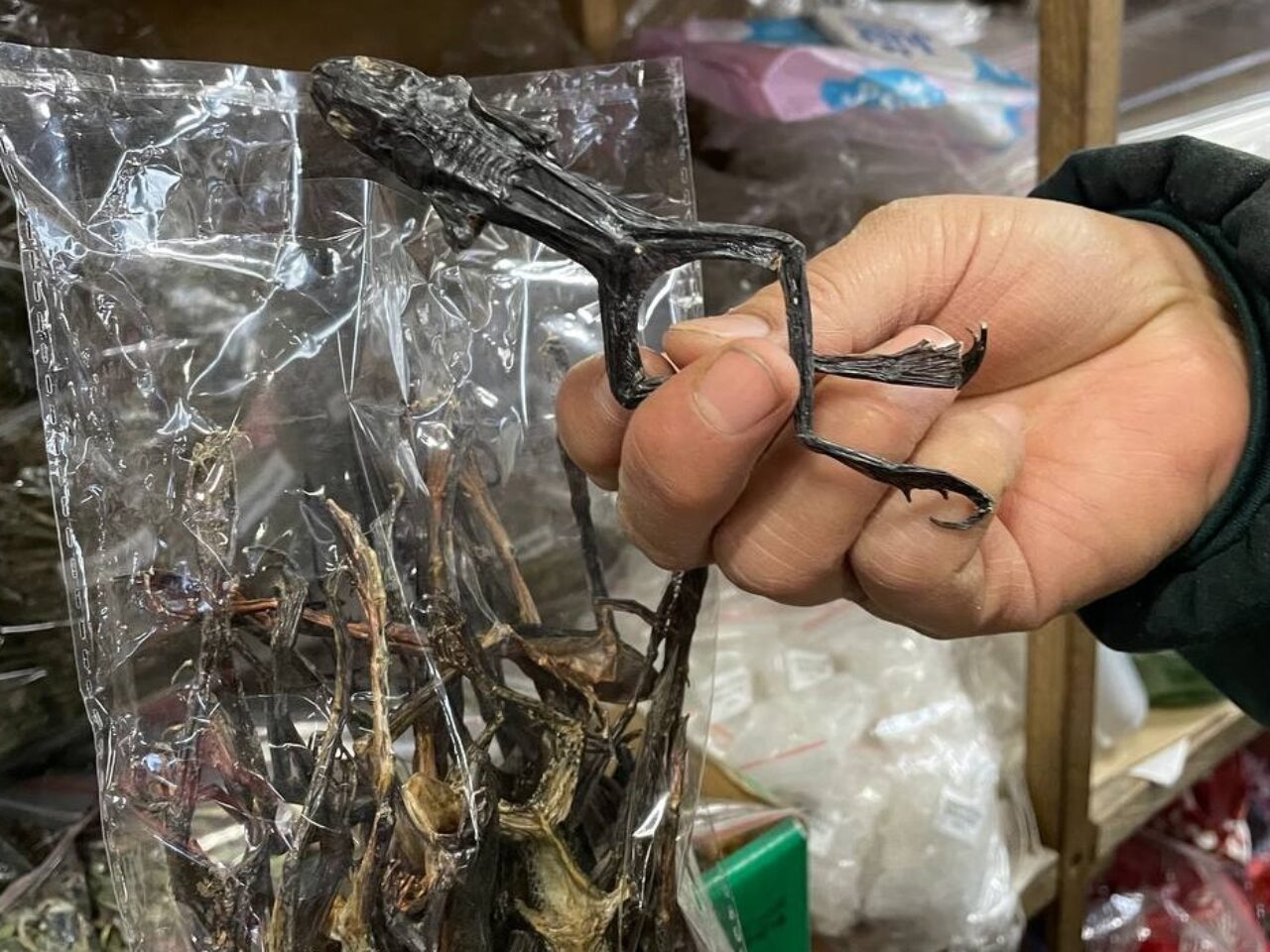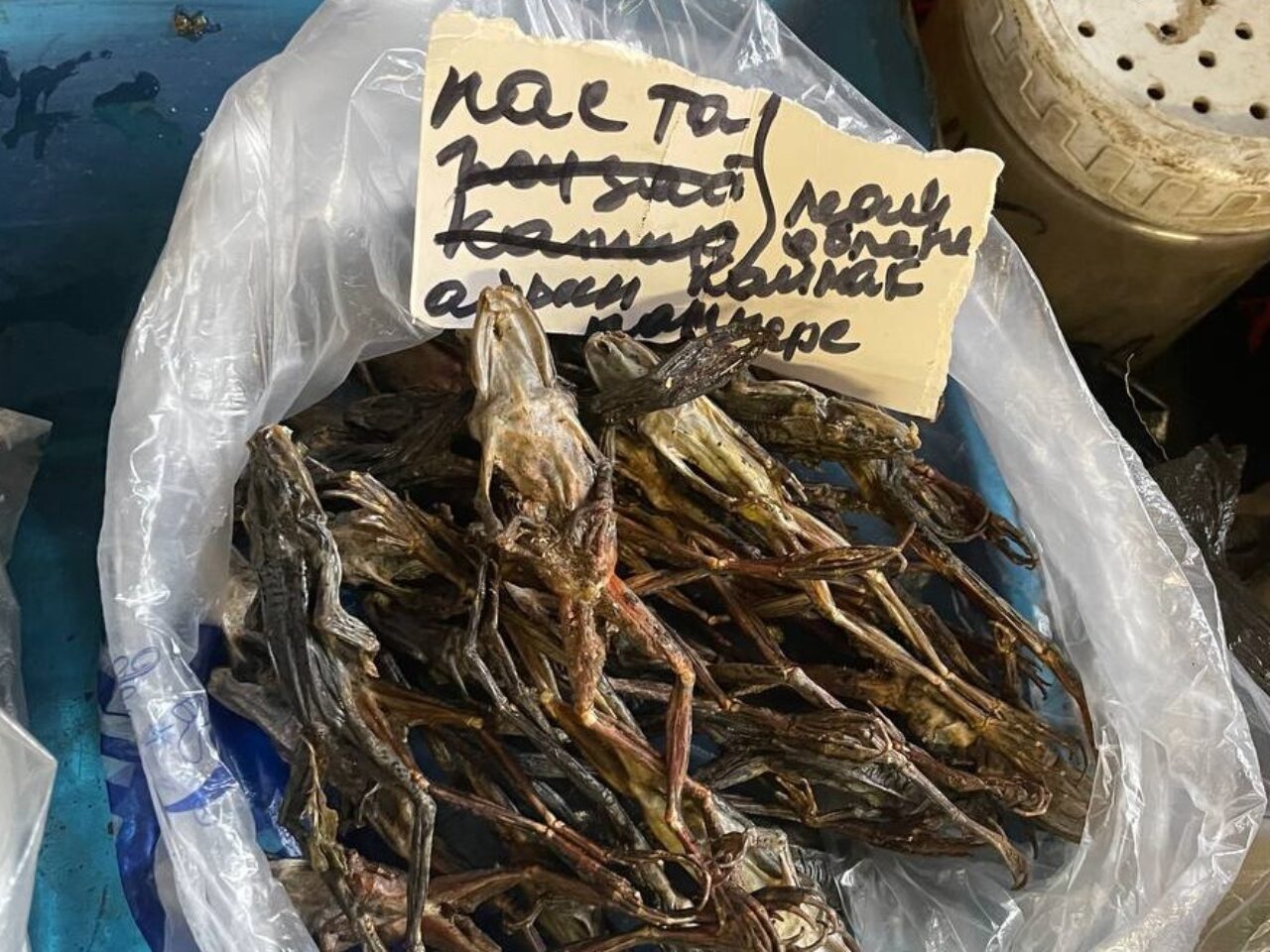Followers of the alternative medicine in Kyrgyzstan believe that the critically endangered Central Asiatic frog (Rana asiatica) improves immunity and even heals from breast cancer. Doctors warn that such methods of treatment are life threatening. Nevertheless, you will not see the rare amphibian in some regions across the country.
The Osh Bazaar in Bishkek is a place where you can find almost everything: from nails to exotic fruits. Every product has its section. Healing herbs are sold next to dried fruit and nuts. Nearly 15 female sellers of medications hide deep inside the section and it’s not easy to find them. There is nothing special on their counters, at first sight: tea bags, herbs, roots of various plants. Once they hear the question “do you have frogs?”, they take out large boxes from under the counter.
Photo: CABAR.asia
One of the sellers, Akmaanai Barpieva, said that she had two species of dried frogs – Central Asiatic and lake frog. She orders them from wholesalers.
“We usually buy them wholesale once a year. We have suppliers from Issyk-Kul and Sokuluk. We used to have suppliers from Naryn, but they supply tiny ones. They said they did not have such species. We order them in May. I buy 400 pieces of each specie. There is also a Chinese frog, but I don’t have it now and it is in small demand anyway. I can sell 20 frogs a week easily. Central Asiatic frog costs 250 som (2.8 dollars) each, lake frog costs 230 som (2.24 dollars). They are usually bought for oncological patients. I am not sure myself, but they say they boost immune system of a human,” Barpieva said.
She has snakes from Tajikistan. In spring, according to the woman, she will have live frogs.
“May is the time of live Central Asiatic frogs. Come then and you’ll see. We keep them in closed boxes. They are in high demand for treatment. They will be more expensive, 400 som (4.47 dollars) each,” she said.
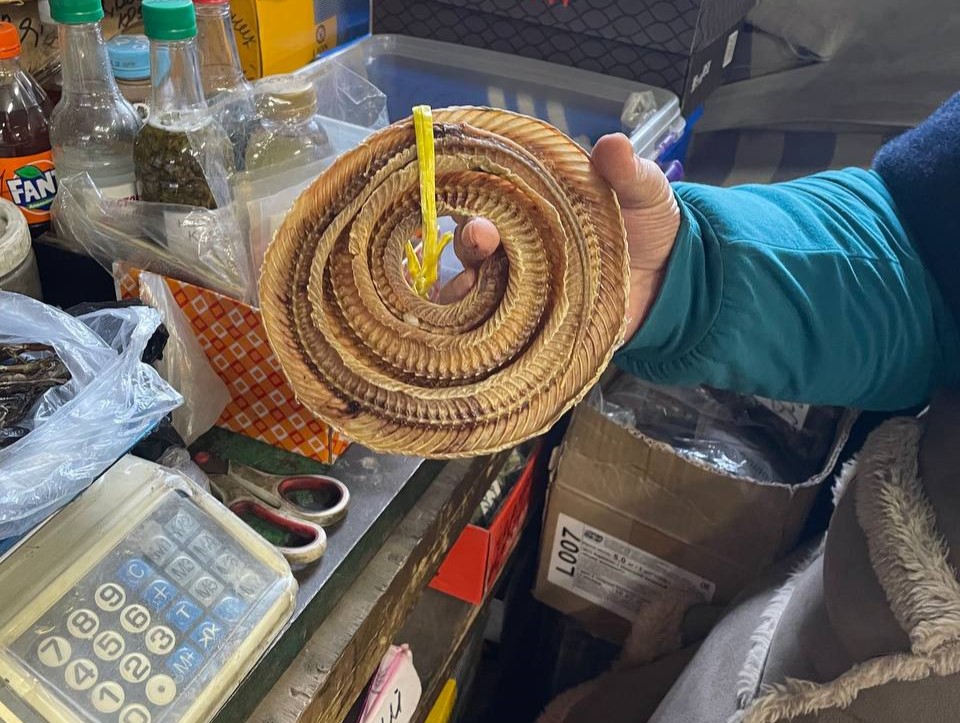
A Central Asiatic frog is on the Red Book of Endangered Species of Kyrgyzstan. This amphibian specie is very rare today. The reason is mass trapping and climate change – air temperature increases every year and some reservoirs, where frogs dwell, get dry, according to Anara Alymkulova, doctor of biological sciences, member of the Academy of Sciences of Kyrgyzstan.
“Last year, we were at the Osh Bazaar and were just enraged when we saw that they sold the rare frog in packs, 200-250 som each. It is priceless!,” Alymkulova said.
According to her, there were about 400 frogs per one hectare in Naryn region 14 years ago, and it was considered critically small. And now, she said, there is a two- or even three-fold decrease in the number of frogs.
“When frogs were not sold on the market, they were not exterminated in such numbers. They have been sold so easily in the last five years,” the biologist said. “It is sold not only in Kyrgyzstan, but also sent to China. And it makes me very sad. When we talked to ecologists from Naryn region, they said there is no critically endangered frog in Kochkor district.”
According to her, the frog inhabits only the eastern part of Issyk-Kul region and partially Chui valley.
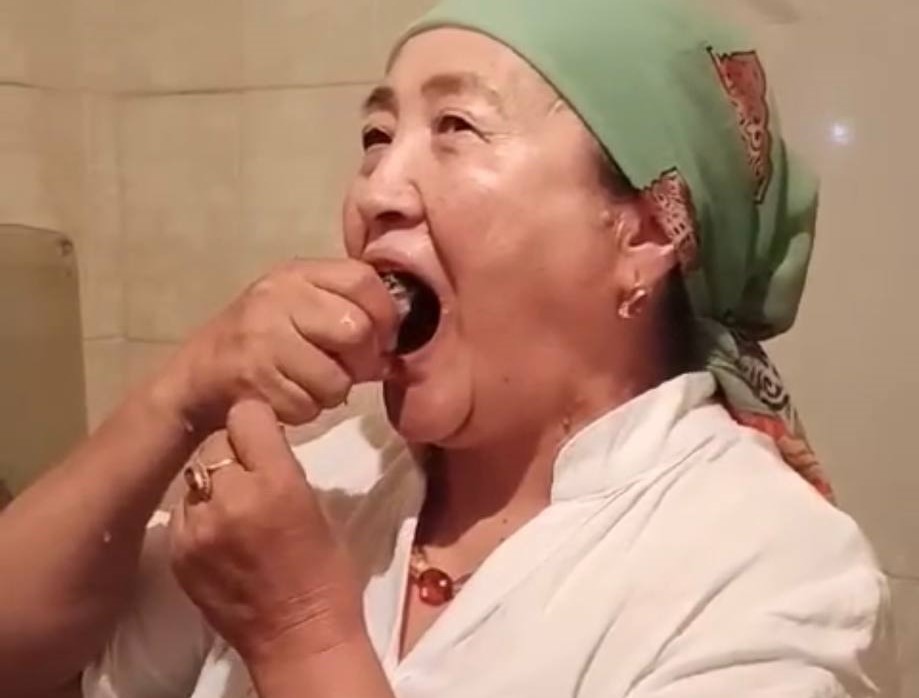
Nevertheless, the demand for the Central Asiatic frog is high in the market. Healer Tashbu Zhamilova runs social media accounts and promotes alternative medicine widely. Her video of the master class on the use of Central Asiatic frog has received most views on her account. She believes that the critically endangered frog treats breast cancer.
“This video about frogs was recorded over three years ago. But it is still relevant. Women come to me and ask me to show and teach them. I help them. But now I have a slightly different direction. Now I treat skin conditions and I treat by means of herbs,” she said.
The healer knows that the Central Asiatic frog is a rare species, but it does not bother her.
Another healer Duishon Chomo uulu, of Kara-Balta, believes it is wrong to think that a frog can treat from oncological diseases. But, according to him, its meat has useful properties, which boost the immune system, and also help deal with pancreatitis.
“I recommend the Central Asiatic frog to those who have problems with the stomach, joints and people with migraine,” the healer said.
According to him, frogs can be dried up, and also used in soup, which helps to cope with migraine.
Don’t believe a single word
Meanwhile, doctors are totally against folk methods of treatment by frogs. Breast physician Sergei Buyuklyanov said that women with advanced cases of breast cancer come to his centre more often.

“In the last two years, women who come often have stage three or four breast cancer. It is often related to untimely medical check-ups of women. Such patients are often come from regions,” he said.
According to Buyuklyanov, there were cases in his 30 years of work when the reason of the advanced case was alternative medicine.
“Such cases are not rare and it is too bad that it happens now, when people have access to internet and information. Last year, there was a 50-year-old woman from Osh region. She said she drank some roots, and rubbed some herbs into her breast. She believed that it could help her get healed from cancer. She lost the most precious thing, i.e. time. As a result, we had to ablate two breasts in order to save her life,” Buyuklyanov said.
Breast physician called not to go to folk healers.
“Don’t trust a single word – this is what I would tell about such healers. They cripple people. There might be cases when a person heals. But there are single cases and they might be by pure accident. It is life threatening to be treated with frogs. I am unaware if there were any studies on the content of frogs. But in terms of sanitation, no one knows how there were dried, where the frog dwelled. So, only evidence-based medicine and professional advice can help the patient,” the doctor said.
Important for a human and ecosystem
Doctor of biological sciences Anara Alymkulova said that frogs are essential participants of the ecosystem of Kyrgyzstan and their extinction will break the food chain.
According to her, the mosquito population will grow without frogs. And it means that malaria and other virus diseases can make a serious harm to the people’s health. And the most dangerous thing is when the unique frog becomes extinct, the greenhouse effect will increase.
“If there are too many insects, they eat too much compost and new plants do not have enough nutrients in soil. And it means that more trees will die and more carbon dioxide will be released. But there would be fewer plants that could capture it. And it all will increase the greenhouse effect. We might think what frogs have to do with it. But they are the main factor of control of the number of insects in nature,” Alymkulova said.
Not only the Central Asiatic frog is under the threat of extinction. According to biologist Ilya Domashov, the eastern steppe viper, which lives in the piedmont area in Dzhalal-Abad and Chui region, is also on the brink of extinction due to the increase in the area of croplands and urbanisation.
“Its natural habitat gets destroyed. The last time its population was recorded was in the 1970s. There were 50 snakes per one hectare then. Now the number is lower, I think. Crops are raised and mining operations are carried out in their habitat. It all leads to its migration to other areas. They have nothing to eat, so they become extinct,” Domashov said.
The Central Asian tortoise is also in trouble. It is the only reptile in Kyrgyzstan. It dwells both in the south and in the north of Kyrgyzstan. It can be often seen in the town of Mailuu-Suu, Dzhalal-Abad region.
“According to latest estimates of specialists, there are 46 species per 10 kilometres in Mailuu-Suu. In Naryn region, there are less than 10 species per day. But Chui region has the most critical indicators – 2 species per day,” he said.
“The reason of extinction is also man-made, the habitat gets destroyed due to the increasing area of pastures and farming lands. But the most important thing is smuggling,” Ilya Domashov said.
“Now online stores sell tortoises for 1,000 som (11,17 dollars) each. You can buy it in every pet shop. In 2012-2015, it was massively caught and exported,” the biologist said.
At the end of 2020, by order of the cabinet of ministers of Kyrgyzstan, the fine for illegal hunting of critically endangered species was increased. Now the fine varies from 1 thousand to 1 million som (11 to 11.2 thousand dollars) depending on the specie.
Ministry of Natural Resources, Ecology and Technical Supervision of the Kyrgyz Republic monitors the illegal trade of frogs and tortoises. According to the press service of the agency, they perform scheduled raids on markets and pet shops.
“The fine of 1 to 20 thousand som (11 to 223 dollars) can be charged for selling a Central Asiatic frog in Kyrgyzstan. Last year, we fined over 10 sellers. The fine for selling tortoises is even more – 3 to 30 thousand som (33.5 to 335 dollars), it depends on the age. Last year, two pet shops were fined in Bishkek,” said Aisuluu Isabekova, press secretary of the ministry of natural resources.
https://cabar.asia/en/rare-amphibians-disappear-in-kyrgyzstan-because-of-their-use-in-alternative-medicine


